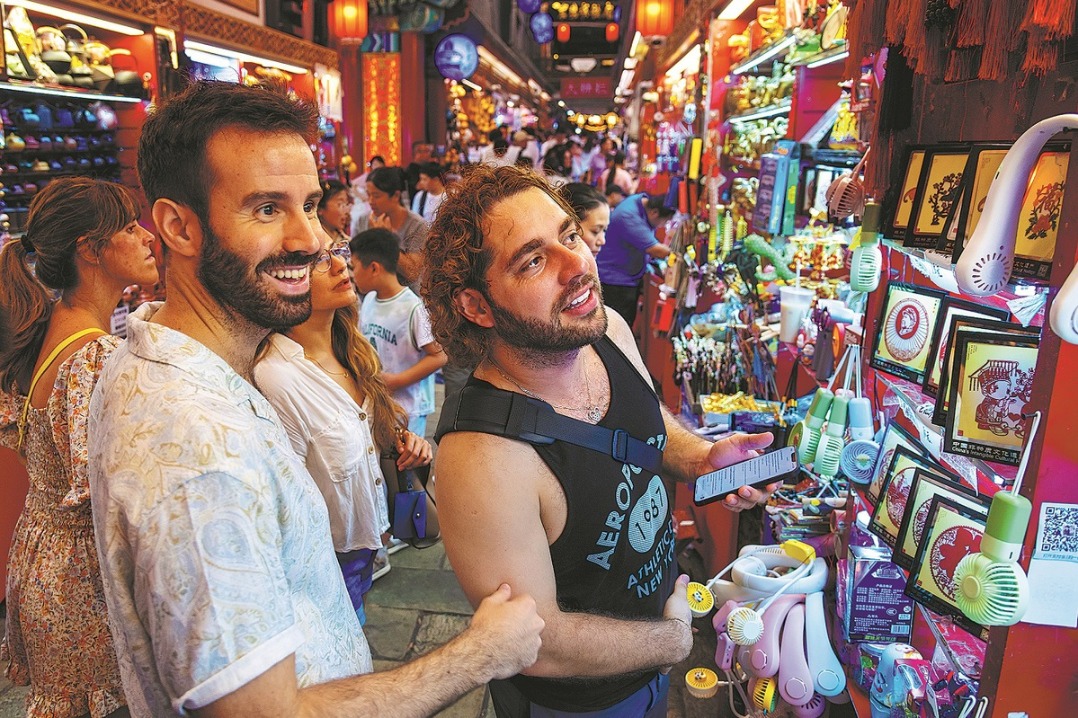Region south of the Yangtze River guarantees to put a spring in my step

Jiangnan, which literally means south of the Yangtze River and refers to the region around the lower reaches of the river, is far more than a geographic concept. The region, which has inspired numerous poems and paintings, has close ties with springtime.
While people were encouraged to spend their Qingming holiday locally, touring nearby scenic sites or riding the wave of virtual tourism from home, I couldn't help missing my trip last spring to the Jiangnan region more than 1,000 kilometers away.
Qingming, also known as Tomb Sweeping Day, is a springtime solar term in the Chinese lunar calendar. It generally falls in early April, and this year the three-day holiday ended on Tuesday. It is traditional to go on an outing or enjoy outdoor activities during the festival.
The season centering around the festival is an ideal time to visit Jiangnan. The region, frequently depicted in Chinese poems and paintings since ancient times, has all sorts of pleasant associations with springtime for me. Both bring a feeling of renewal, warmth, moisture and gentleness, which is appealing especially as the winter chill has just faded away.
So I decided to take my elderly mother on a holiday trip to Hangzhou, a city typical of the Jiangnan style, to feel the vibrancy of the season.
When we departed from Beijing by train in late March last year, a couple of days ahead of Qingming, willows lining the streets in the northern municipality had just sprouted, as if they were shrouded in a thin mist of light greenness seen from afar.
In contrast, their peers standing along the banks of the West Lake, a popular attraction in Hangzhou, East China's Zhejiang province, flourished, swaying in the spring breeze like dancers dressed in luxuriant green gowns, stretching their arms and twisting their waists.
Unlike other lakes in walled parks or those in the countryside, the West Lake is situated in the city's downtown area and is open to residents and tourists, unfenced and free of charge.
The nearly 60-square-kilometer West Lake Scenic Area, which includes attractions around the centerpiece lake, is known as the city's calling card due to its beauty throughout the seasons.
Rich in myth and legend, it provided settings for classic romance stories including The Legend of White Snake where the snake-turned-lady's husband Xu Xian met her on the Duanqiao Bridge, or Broken Bridge, on the lake; and The Butterfly Lovers where the two lovers-Liang Shanbo and Zhu Yingtai-spent their three school years at the nearby Wansong Academy in Hangzhou. When Zhu was to return home, Liang walked her to the Changqiao Bridge, or Long Bridge.
Despite their names, Broken Bridge is not broken and Long Bridge is not long, a local tour guide said.
Seen from above, the Broken Bridge appears broken due to different patches of snow melting in the winter. Some parts of it remain covered with snow while others have thawed away. The Lingering Snow on the Broken Bridge is one of the lake's 10 signature scenes.
The Long Bridge earned its name thanks to the couple in The Butterfly Lovers, according to the guide. When Liang was seeing Zhu off on the bridge, they hesitated to part. As a result, they moved back and forth over the bridge several times.
Ranking among world heritage sites, the West Lake itself is home to more than 60 heritage sites at the national, provincial or city level and over 20 museums and memorial halls. It attracted more than 30 million visits from home and abroad in 2019 before the COVID-19 outbreak, according to its official website.
Walk by the lakeside
Due to the pandemic, the scenic area was not that crowded as I had expected, which came as a pleasant surprise to me. Neither had I to face the dizzy flow of tourists nor elbow my way through the crowds.
Among the lake's signature scenes, the Spring Dawn at Su Causeway was associated with Su Shi, a renowned Song Dynasty (960-1279) poet.
When he served as the head of the Hangzhou government in his 50s, he led locals to dredge the lake in a bid to restore its beauty. The earth left after the cleanup project was used to build a causeway spanning nearly 3 km across the lake, which was named after Su in memory of his contribution to the city.
Along the Su Causeway stand willows, dotted with various flowering trees, including peach trees. When they're in full bloom, the pink and red blossoms between drooping willows along the boulevard signal the arrival of spring.
Strolling along the causeway, we occasionally came across young women wearing ancient-style long dresses taking selfies. Such smiling faces in the full bloom of youth among the spring flowers could always put onlookers in a relaxed and amiable mood.
Walking all the way could have been challenging to my mother, who is in her late 70s and cannot complete a long walk since hip surgery in 2018.
Fortunately, the walk was punctuated with park benches by the lakeside, although it was not easy to find an empty one.
We also had a walk by the lakeside at the Orioles Singing in the Willows, another signature attraction of the West Lake. It is a park situated on the southeast bank of the lake, covering 17 hectares.
There, we looked across a large lawn at primary school students passing the willows in a line along the lake in a spring outing organized by their school. If life could be divided into four seasons, these children must also be in spring.
At the Breeze-Ruffled Lotus at Quyuan Garden, another scenic area by the lakeside, we met tour groups mainly comprised of the elderly. Wearing uniform caps, the tourists in their 60s and 70s either focused their professional lenses on flowering trees or posed for a selfie under sakura plants with a smartphone.
Their enthusiasm gave me second thoughts about the four seasons of life. Whether young or old, when people decide to embrace the sunshine of life, springtime could always be with them.
Data from travel platforms show that the demand from elderly people for tailored tours has gained momentum and their spending on leisure tours is on the rise.
Adjacent to the Breeze-Ruffled Lotus at Quyuan Garden stands the Guozhuang, or Guo's Villa. It was a private villa and is now a public park.
With typical traditional Chinese architecture-such as a long corridor, pavilions, a bridge and rockeries-the villa has a pond at the heart of its backyard, with lotus leaves floating on the water and fish swimming underneath. The pond is connected with the West Lake via a short artificial channel and a water gate.
What impressed me was a wide platform stretching out from the garden onto the West Lake. The famed lake has been incorporated into the private villa's scenery.
Taking advantage of the lakeside platform, there is a cafe providing refreshments.
Seasonal taste
After a cruise along the Hangzhou section of the ancient Beijing-Hangzhou Great Canal, we took a taxi to a nearby well-preserved historical commercial and residential block, with a river running through. It comprises lanes lined with shops and dwellings.
We drank green tea on the balcony of a riverside teahouse. It is the right season to have the Mingqian-literally pre-Qingming-tea, as it is harvested before Qingming.
The seasonal tea is known for its tender leaves, fresh flavor and low yield. Locals say it is so expensive that its value can rival that of gold.
Longjing village near the West Lake is a major production center of Longjing tea. Around Qingming every year, gourmets from different parts of the country go to local teamakers to buy the product.
More than a decade ago, I traveled with friends along a winding mountain route passing the village, which provided spectacular views.
Considering the travel route was not suitable for the elderly, I had to give it up in our itinerary last year. Instead, I chose a restaurant with a tea garden for dinner.
The restaurant was so popular that without a reservation, we had to wait in line for about half an hour for a table to become available. It turned out that the delights offered made it worth the wait.





Today's Top News
- China's industrial profits down 1.8% in H1
- Thailand responds to Trump's ceasefire call
- Recall vote shows DPP's manipulation runs against Taiwan people's will: mainland spokesperson
- Top DPRK leader visits China-DPRK Friendship Tower
- China proposes global cooperation body on AI
- Scholars propose inclusive human rights framework






























